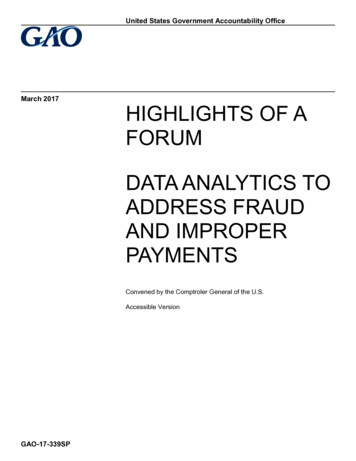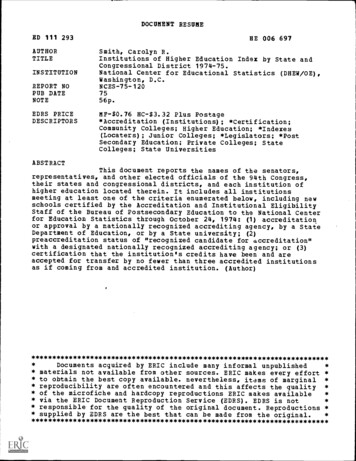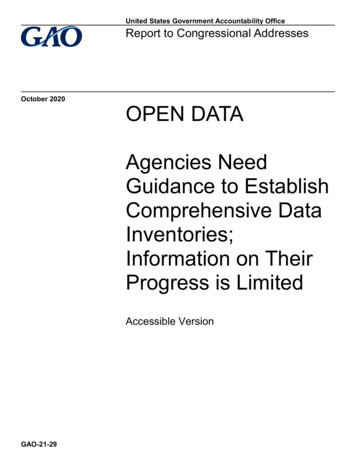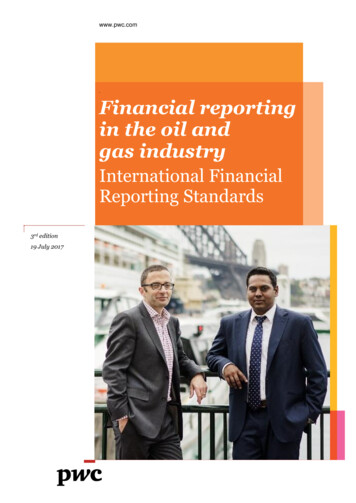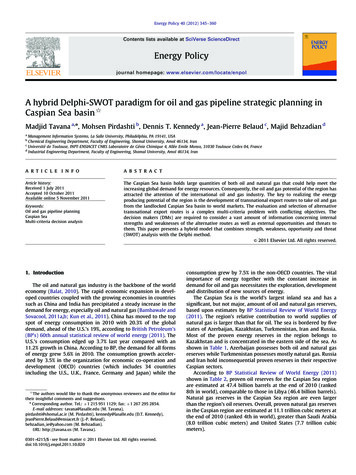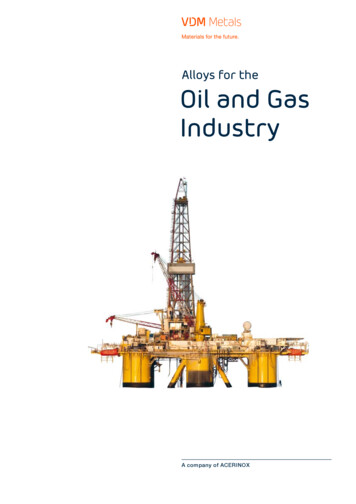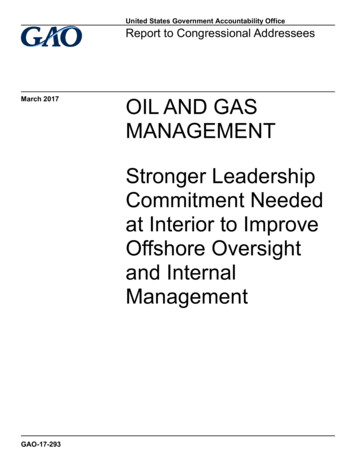
Transcription
United States Government Accountability OfficeReport to Congressional AddresseesMarch 2017OIL AND GASMANAGEMENTStronger LeadershipCommitment Neededat Interior to ImproveOffshore Oversightand InternalManagementGAO-17-293
March 2017OIL AND GAS MANAGEMENTHighlights of GAO-17-293, a report tocongressional addresseesStronger Leadership Commitment Needed atInterior to Improve Offshore Oversight andInternal ManagementWhy GAO Did This StudyWhat GAO FoundOn April 20, 2010, the DeepwaterHorizon drilling rig exploded in the Gulfof Mexico. The incident raisedquestions about Interior’s oversight ofoffshore oil and gas activities. Inresponse, in May 2010, Interiorreorganized its offshore oil and gasmanagement activities, and in October2011, created BSEE to among otherthings, develop regulations, conductinspections, and take enforcementactions. In February 2011, GAO addedthe management of federal oil and gasresources to its High-Risk List. InDecember 2015, BSEE issued astrategic plan outlining initiatives toimprove offshore safety andenvironmental oversight as well as itsinternal management.The Department of the Interior’s (Interior) Bureau of Safety and EnvironmentalEnforcement (BSEE) leadership has started several key strategic initiatives toimprove its offshore safety and environmental oversight, but its limited efforts toobtain and incorporate input from within the bureau have hindered its progress.For example, to supplement its mandatory annual regulatory complianceinspections, in 2012, BSEE leadership began developing a risk-based inspectioninitiative to identify high-risk production facilities and assess their safety systemsand management controls. During pilot testing in 2016, several deficiencies—including the usefulness of its facility risk-assessment model and unclearinspection protocols—caused BSEE to halt the pilot. According to bureauofficials, during the development of the initiative, BSEE headquarters did noteffectively obtain and incorporate input from regional personnel with longstanding experience in previous risk-based inspection efforts, who could haveidentified deficiencies earlier in the process. GAO previously found that whenimplementing large-scale management initiatives a key practice is involvingemployees to obtain their ideas by incorporating their feedback into new policiesand procedures. Instead, BSEE leadership appears to have excluded the input ofregional personnel by, for example, not incorporating input beyond the riskassessment tool when selecting the first pilot facility, even though it wasprescribed to do so in the bureau’s inspection planning methodology. Thisundercut the pilot effort, raising questions about whether the bureau’s leadershiphas the commitment necessary to successfully implement its risk-basedprogram. Without higher level leadership within Interior establishing amechanism for BSEE to obtain and incorporate input from personnel within thebureau, BSEE’s risk-based inspection initiative could face continued delays.This report examines what effortsBSEE leadership has made inimplementing key strategic initiatives toimprove its (1) offshore safety andenvironmental oversight and (2)internal management. GAO reviewedlaws, regulations, policies, and otherdocuments related to the developmentof BSEE’s strategic initiatives. GAOalso interviewed BSEE officials.What GAO RecommendsGAO is making four recommendations,including that higher-level leadershipwithin Interior (1) establish amechanism for BSEE management toobtain and incorporate input frombureau personnel that can affect thebureau’s ability to achieve itsobjectives and (2) address leadershipcommitment deficiencies within BSEE,including by implementing internalmanagement initiatives and ongoingstrategic initiatives in a timely manner.Interior neither agreed nor disagreedwith our recommendations.View GAO-17-293. For more information,contact Frank Rusco at (202) 512-3841 orruscof@gao.gov.Similarly, since 2013, BSEE leadership has started several key strategicinitiatives to improve its internal management, but none have been successfullyimplemented, in part, because of limited leadership commitment. For example,BSEE’s leadership identified the importance of developing performancemeasures in its 2012-2015 strategic plan. BSEE began one of three attempts todevelop performance measures in July 2014 by hiring a contractor to developmeasures, but the bureau terminated this contract in January 2015 afterdetermining a need to complete its internal reorganization before developingsuch measures. A second effort to develop performance measures started inDecember 2015, using the same consultant, and yielded 12 performancemeasures in March 2016, but BSEE did not implement them, in part, becausedata did not exist to use the measures. By the time BSEE received thisconsultant’s report, it had already begun a third effort to internally developperformance measures; as of November 2016 had identified 17 draftperformance measures, but BSEE leadership missed repeated deadlines toreview them. BSEE officials told GAO that after leadership approval, the bureauplans to pilot these measures and develop others. BSEE leadership has notdemonstrated continuing oversight and accountability for implementing internalmanagement initiatives, as evidenced by its limited progress implementing keystrategic initiatives. Without higher-level oversight within Interior addressingleadership commitment deficiencies within BSEE, the bureau is unlikely tosucceed in implementing internal management initiatives.United States Government Accountability Office
ContentsLetter1BackgroundBSEE Leadership Has Started Several Initiatives to Improve theBureau’s Safety and Environmental Oversight Capabilities butIts Actions Have Hindered ProgressBSEE Leadership Has Made Limited Progress in ImplementingStrategic Initiatives to Improve Its Internal ManagementConclusionsRecommendations for Executive ActionAgency Comments and Our Evaluation419323334Appendix IComments from the Department of the Interior40Appendix IIGAO Contact and Staff Acknowledgments447AbbreviationsArgonneArgonne National LaboratoryBOEMBureau of Ocean Energy ManagementBOEMREBureau of Ocean Energy, Management, Regulation andEnforcementBSEEBureau of Safety and Environmental EnforcementERMEnterprise Risk ManagementIGOffice of Inspector GeneralINCincident of noncomplianceInteriorDepartment of the InteriorIPRAIntegrity and Professional Responsibility AdvisorIRUInvestigations and Review UnitMMSMinerals Management ServiceNAPANational Academy of Public AdministrationNEPANational Environmental Policy ActOCSouter continental shelfOCSLAOuter Continental Shelf Lands ActSEMSSafety and Environmental Management SystemThis is a work of the U.S. government and is not subject to copyright protection in theUnited States. The published product may be reproduced and distributed in its entiretywithout further permission from GAO. However, because this work may containcopyrighted images or other material, permission from the copyright holder may benecessary if you wish to reproduce this material separately.Page iGAO-17-293 Oil and Gas Management
Letter441 G St. N.W.Washington, DC 20548March 21, 2017The Honorable Jason ChaffetzChairmanCommittee on Oversight and Government ReformHouse of RepresentativesThe Honorable Rob BishopChairmanThe Honorable Raúl GrijalvaRanking MemberCommittee on Natural ResourcesHouse of RepresentativesThe Honorable Blake FarentholdChairmanSubcommittee on the Interior, Energy, and EnvironmentCommittee on Oversight and Government ReformHouse of RepresentativesOn April 20, 2010, the Deepwater Horizon drilling rig exploded in the Gulfof Mexico, resulting in 11 deaths, serious injuries, and the largest marineoil spill in the history of the United States. The Deepwater Horizonincident raised questions about the Department of the Interior’s (Interior)oversight of offshore oil and gas activities in the Gulf of Mexico and led toinvestigations by Interior’s Office of Inspector General (IG) 1 and Interior’sOuter Continental Shelf (OCS) Safety Oversight Board. 2 In response tothe Deepwater Horizon incident, Interior initiated a number of policyreforms intended to strengthen its oversight of offshore oil and gasproduction on the OCS. On May 19, 2010, Interior reorganized the1U.S. Department of the Interior, Office of Inspector General, A New Horizon: Looking tothe Future of the Bureau of Ocean Energy Management, Regulation and Enforcement(Washington, D.C.: Dec. 7, 2010).2The OCS refers to the submerged lands outside the territorial jurisdiction of all 50 states,but within U.S. jurisdiction and control. The portion of the North American continental edgethat is federally designated as the OCS generally extends seaward 3 geographical milesoff the coastline to at least 200 nautical miles. The OCS Safety Oversight Board wascreated by secretarial order to review and oversee Interior OCS operations to supportreasoned and fact-based recommendations for potential improvement. See U.S.Department of the Interior Outer Continental Shelf Safety Oversight Board, Report toSecretary of the Interior Ken Salazar (Sept. 1, 2010).Page 1GAO-17-293 Oil and Gas Management
Minerals Management Service (MMS)—the agency responsible formanaging oil and gas activities in federal waters and collecting revenuesfrom oil and gas development on all federal lands and waters—to improvethe management, oversight, and accountability of activities on the OCS. 3As an interim step, Interior restructured MMS into the Bureau of OceanEnergy, Management, Regulation and Enforcement (BOEMRE),responsible for offshore oil and gas management and the Office ofNatural Resources Revenue responsible for revenue collections. OnOctober 1, 2011, Interior completed the reorganization of MMS bysplitting BOEMRE into the Bureau of Ocean Energy Management(BOEM), which is responsible for leasing and resource management, andthe Bureau of Safety and Environmental Enforcement (BSEE), which isresponsible for reviewing drilling permits, inspecting offshore drilling rigsand production platforms, and developing regulations and standards foroffshore drilling.Over the past several years, we have issued a number of reportsidentifying Interior’s challenges in managing federal oil and gasresources. The balance of our work has shown that management offederal oil and gas resources was a high risk area and we added it to theHigh Risk List in 2011. 4 We identified challenges in Interior’smanagement of oil and gas on leased federal lands and waters. We foundthat Interior (1) did not have reasonable assurance that it was collectingits share of revenue from oil and gas produced on federal lands andwaters; (2) continued to experience problems hiring, training, andretaining sufficient staff to provide oversight and management of oil andgas operations on federal lands and waters; and (3) was undertaking amajor challenging reorganization of its oversight of both its offshore oiland gas management and revenue collection functions.3Secretarial Order No. 3299 (May 19, 2010).4GAO, High-Risk Series: An Update, GAO-11-278 (Washington, D.C.: February 2011). In1990, we began a program to report on government operations that we identified as “highrisk.” Since then, generally coinciding with the start of each new Congress, GAO hasreported on the status of progress to address high-risk areas and to update the High RiskList. Overall, GAO’s high-risk program has served to identify and help resolve seriousweaknesses in areas that involve substantial resources and provide critical services to thepublic. Our experience with the high-risk series over the past 25 years has shown that thekey elements needed to make progress in high-risk areas are top-level attention by theadministration and agency leaders grounded in the five criteria for removal from the HighRisk List, as well as any needed congressional action. The five criteria for removal are: (1)leadership commitment, (2) capacity, (3) action plan, (4) monitoring, and (5) demonstratedprogress.Page 2GAO-17-293 Oil and Gas Management
In February 2016, we reported that BSEE’s ongoing organizationalrestructuring—which it initiated in October 2013 to develop nationalprograms—had not addressed long-standing deficiencies to itsinvestigative, environmental compliance, and enforcement capabilities. 5To enhance its ability to effectively oversee offshore oil and gasdevelopment, we recommended that the Secretary of the Interior directthe Director of BSEE to take nine actions, including that BSEE completepolicies outlining the responsibilities of its investigative, environmentalcompliance, and enforcement programs and update and developprocedures to guide them. Interior neither agreed nor disagreed with ourrecommendations. Simultaneous to our assessment of BSEE’sorganizational restructuring, bureau leadership was developing its FiscalYear 2016-2019 Strategic Plan, which identifies key initiatives to improveits safety and environmental oversight as well as its internal management.Some of these key strategic initiatives have been under way for severalyears.In light of the concerns we identified during our review of BSEE’sorganizational restructuring, we initiated this review under the authority ofthe Comptroller General of the United States. 6 This report examinesefforts BSEE leadership has made in implementing key strategicinitiatives to improve its (1) safety and environmental oversight and (2)internal management. 7To identify progress BSEE leadership has made in implementing keystrategic initiatives to improve its (1) safety and environmental oversightand (2) internal management, we reviewed BSEE strategic planning andbudget justification documentation as well as interviewed BSEEleadership to identify key bureau strategic initiatives. We then reviewed5GAO, Oil and Gas Management: Interior’s Bureau of Safety and EnvironmentalEnforcement Has Not Addressed Long-Standing Oversight Deficiencies, GAO-16-245(Washington, D.C.: Feb. 10, 2016).6Based on our February 2016 report regarding BSEE’s oversight capabilities as well asongoing work in support of this report, in February 2017, we expanded the High Risk Listto incorporate the restructuring of offshore oil and gas oversight. See GAO, High-RiskSeries: Progress on Many High-Risk Areas, While Substantial Effort Needed on Others,GAO-17-317 (Washington, D.C.: Feb. 15, 2017).7In August 2016, BSEE contracted with the National Academy of Public Administration(NAPA) for approximately 450,000 to assess the bureau’s progress in institutionalizingthe systems, policies and process since its 2011 establishment and determine whereareas of critical need remain to be addressed to ensure a functioning and sustainableorganization. NAPA is scheduled to deliver its final report to BSEE in March 2017.Page 3GAO-17-293 Oil and Gas Management
BSEE’s strategic initiatives and focused on those that corresponded toour objectives and were topics that we have not reviewed in the last 2years. 8 For each initiative, we collected and analyzed BSEEdocumentation of their purpose and history—including budgetjustifications, project plans, and contracts, among others—to determinetheir objectives, time frames, and status. We also interviewed BSEEofficials at headquarters responsible for bureau and program leadershipas well as officials in the regional and district offices responsible forimplementing BSEE oversight activities. For each initiative, we analyzedany progress made and compared BSEE practices for implementing itsinitiatives to bureau criteria—such as strategic plans and initiative goals—as well as Standards for Internal Control in the Federal Government. 9We conducted this performance audit from March 2016 to March 2017 inaccordance with generally accepted government auditing standards.Those standards require that we plan and perform the audit to obtainsufficient, appropriate evidence to provide a reasonable basis for ourfindings and conclusions based on our audit objectives. We believe thatthe evidence obtained provides a reasonable basis for our findings andconclusions based on our audit objectives.BackgroundBSEE’s mission is to promote safety, protect the environment, andconserve resources offshore through vigorous regulatory oversight andenforcement. BSEE’s headquarters—located in Washington, D.C., andSterling, Virginia—is responsible for setting national program policy tomeet the bureau’s mission. BSEE’s three regional offices—the Gulf ofMexico regional office in New Orleans, Louisiana; the Pacific regionaloffice in Camarillo, California; and the Alaska regional office inAnchorage, Alaska—are responsible for executing oversight of oil andgas activities, such as conducting inspections of all facilities on the OCS.The five district offices that the Gulf of Mexico regional office oversees8Within the past 2 years, GAO issued reports on several topics that could be consideredBSEE key strategic initiatives, including its organizational restructuring (GAO-16-245),decommissioning (GAO, Offshore Oil and Gas Resources: Actions Needed to BetterProtect Against Billions of Dollars in Federal Exposure to Decommissioning Liabilities,GAO-16-40 (Washington, D.C.: Dec. 18, 2015)), and human capital challenges (GAO, Oiland Gas Oversight: Interior Has Taken Steps to Address Staff Hiring, Retention, andTraining but Needs a More Evaluative and Collaborative Approach, GAO-16-742(Washington, D.C.: Sept. 29, 2016)).9GAO, Standards for Internal Control in the Federal Government, GAO-14-704G(Washington, D.C.: September 2014).Page 4GAO-17-293 Oil and Gas Management
are the Houma, Louisiana; Lake Jackson, Texas; Lafayette, Louisiana;Lake Charles, Louisiana; and New Orleans, Louisiana district offices.The Outer Continental Shelf Lands Act of 1953, as amended, (OCSLA)requires Interior to inspect each offshore oil and gas facility at least onceper year. 10 OCSLA also authorizes Interior to conduct periodicunscheduled—unannounced—inspections of these facilities. 11 BSEEcarries out these inspections on behalf of the Secretary throughoutAmerica’s 1.7 billion acres of the OCS. BSEE’s Office of OffshoreRegulatory Programs is responsible for overseeing the bureau’s nationalinspection program, which is carried out by the bureau’s regional offices.During inspections, BSEE inspectors scrutinize all safety systemcomponents designed to prevent or ameliorate blowouts, fires, spillages,or other major accidents. Additionally, inspectors check for compliancewith current plans, lease terms, and appropriate stipulations. Duringinspections, BSEE inspectors check for installation, operation, andmaintenance of all appropriate safety and antipollution devices. Theyperform the inspections, in part, by using a checklist derived fromregulated safety and environmental requirements. If an inspectoridentifies a regulatory violation at an offshore facility, BSEE issues acitation to the operator known as an incident of noncompliance (INC) inresponse to operator violations of safety or environmental standards. AnINC may be issued in the form of (1) a warning, (2) an order to shut downa particular component of the facility (when it can be shut down withoutaffecting the overall safety of the facility or operations), or (3) an order toshut down an entire drilling rig or production platform in cases when theviolation could result in serious consequences to the environment orhuman health and safety, such as a fire or spill. 12 Operators generally1043 U.S.C. § 1348(c)(1).1143 U.S.C. § 1348(c)(2).12Interior’s policy is to place operators with a history of poor performance on its increasedoversight list, and inspect those operators more frequently until it determines that theoperator’s performance has improved. BSEE can also place an operator on aperformance improvement plan due to serious incidents, poor performance data, criminalreferral, civil penalties assessed, or uncorrected deficiencies resulting in a probationarystatus. A performance improvement plan may result in more inspections or more frequentinspections, which may result in an increase in INCs issued and civil penalties assessed.Operators may also be required to provide increased information, and have operatoremployees working during certain activities such as construction and simultaneousoperations to facilitate communications.Page 5GAO-17-293 Oil and Gas Management
have 20 days to correct the violation and notify Interior that the violationwas corrected. 13BSEE is responsible for ensuring compliance with OCSLA and provisionsof other federal laws, including the National Environmental Policy Act(NEPA). 14 BSEE’s Environmental Compliance Division establishesnational strategic goals, programs, and procedures to increase theaccuracy, effectiveness, and consistency of all bureau environmentalcompliance policies and initiatives. BSEE’s Office of EnvironmentalCompliance, located in the Gulf of Mexico regional office, is staffed byenvironmental engineers, scientists, and specialists who are responsiblefor BSEE’s NEPA compliance program, as well as field and officeenvironmental compliance verification.We have previously reported on Interior’s challenges with managingfederal oil and gas resources. In September 2008 and July 2009, 15 wefound shortcomings in Interior’s ability to ensure that royalty payment datawere reasonable and complete. In addition, in March 2010, 16 we foundthat Interior’s policies and practices did not provide reasonable assurancethat oil and gas produced from federal leases was being accuratelymeasured and that Interior experienced challenges hiring, training, andretaining qualified staff to provide oversight and management of oil andgas operations on federal lands and waters. Further, we have reportedthat organizational transformations are not simple endeavors and requirethe concentrated efforts of both leaders and employees to realizeintended synergies and accomplish new organizational goals. We werealso concerned about Interior’s ability to balance continued delivery ofservices with transformational activities in view of the department’s historyof management problems and challenges in the human capital area.1330 C.F.R. § 250.1452.1442 U.S.C. §§ 4321-4347. Under NEPA, federal agencies must assess the effects ofmajor federal actions—those they propose to carry out or to permit—that significantlyaffect the environment.15GAO, Mineral Revenues: Data Management Problems and Reliance on Self-ReportedData for Compliance Efforts Put MMS Royalty Collections at Risk, GAO-08-893R(Washington, D.C.: Sept. 12, 2008) and Mineral Revenues: MMS Could Do More toImprove the Accuracy of Key Data Used to Collect and Verify Oil and Gas Royalties,GAO-09-549 (Washington, D.C.: July 15, 2009).16GAO, Oil and Gas Management: Interior’s Oil and Gas Production Verification Efforts DoNot Provide Reasonable Assurance of Accurate Measurement Production Volumes,GAO-10-313 (Washington, D.C.: Mar. 15, 2010).Page 6GAO-17-293 Oil and Gas Management
In December 2015, BSEE issued its Fiscal Year 2016–2019 StrategicPlan. BSEE’s strategic plan identifies strategic goals to improve itsoperations—including safety and environmental oversight—as well as itsinternal management. BSEE’s key strategic initiatives to improve safetyand environmental oversight include developing a risk-based inspectionsprogram and promoting environmental stewardship. BSEE’s key strategicinitiatives to improve its internal management include enhancing decisionmaking as well as communication and transparency.BSEE LeadershipHas Started SeveralInitiatives to Improvethe Bureau’s Safetyand EnvironmentalOversight Capabilitiesbut Its Actions HaveHindered ProgressBSEE leadership has started several initiatives to improve its safety andenvironmental oversight capabilities but its limited efforts to obtain andincorporate input from within the bureau have hindered its progress.Since 2012, BSEE has sought to augment its annual inspection programwith a risk-based inspection program, but limited efforts to obtain andincorporate input from experienced regional personnel have hinderedBSEE’s ability to develop and implement the risk-based program.Additionally, in 2016, BSEE conducted an environmental stewardshipinitiative comprised of two simultaneous environmental risk reductionefforts, but these efforts were overlapping, fragmented, anduncoordinated, which reduced the effectiveness of the initiative andhindered the implementation of identified improvements.Limited Efforts to Obtainand Incorporate Input fromRegional PersonnelHindered the Developmentand Implementation ofRisk-Based InspectionInitiativeSince it was established as a separate bureau in 2011, BSEE leadershiphas continued an initiative begun by its predecessor to transition thebureau’s inspection program to a risk-based approach. In 2012, BSEEleadership started a new initiative that included the development of a riskmodel and an approach for inspecting production facilities based on therisk they pose. However, BSEE leadership’s limited efforts to obtain andincorporate input from regional staff and management duringdevelopment of the program led to poor pilot results. As a result, BSEEhas changed the focus of the program and reduced expectations for itsinitial approach to risk-based inspections.Page 7GAO-17-293 Oil and Gas Management
BSEE Leadership Began aNew Initiative to Develop aRisk-Based InspectionProgram, but the InitialApproach Had SeveralDeficienciesInterior’s efforts to conduct oversight based on risk date back to the1990s. 17 In 1998, MMS, BSEE’s predecessor organization, contracted fora study from Carnegie Mellon University to develop a model to targetinspections of offshore facilities based on risk. MMS did not implementthe model at the time because it was too complex, according to BSEEofficials. In 2009, one year prior to the Deepwater Horizon incident andthe dissolution of the MMS in 2010, the Gulf of Mexico Regional Officepiloted a risk-based inspection strategy in the Houma, Louisiana andLake Jackson, Texas districts that regional management recommendedfor immediate implementation. However, BSEE officials told us that the2010 Deepwater Horizon incident and Interior’s 2010 Safety andEnvironmental Management System (SEMS) regulation 18 prompted thebureau to reconsider approaches to conducting risk-based inspections.Since 2011, when it was established as the successor to MMS, BSEEhas highlighted in every Interior budget justification for the bureau itsongoing efforts to identify and increase oversight of the highest-riskfacilities and operators. Additionally, BSEE affirmed its intentions in its2016-2019 Strategic Plan to develop this risk-based inspection capabilityas part of its National Inspection Program. 19Beginning in 2012, BSEE began an initiative to develop an approach forconducting inspections of offshore facilities based on the level of risksthey posed. Specifically, BSEE engaged Argonne National Laboratory(Argonne) to develop a quantitative model to serve as the foundation of17For example, in the 1990s, the policy of MMS was to conduct inspections of safetydevices using a risk-based sampling procedure.1830 C.F.R. Part 250, subpart S. BSEE requires operators to have a SEMS program toidentify, address, and manage safety, environmental hazards, and impacts during thedesign, construction, start-up, operation, inspection, and maintenance of all new andexisting OCS facilities. The focus of the Safety and Environmental Management Systemprogram is on promoting an operator-driven system that continually improves safetyculture and safety practices within the industry.19BSEE’s long-term transition to a risk-based approach to safety inspection aligns with a2016 recommendation made by the National Research Council’s Transportation ResearchBoard in Strengthening the Safety Culture of the Offshore Oil and Gas Industry onOctober 1, 2016. Specifically, the Board recommended that BSEE make greater use ofrisk principles in determining inspection frequencies and methods, such that operatorswith good performance records are subject to less frequent or less details inspections. Inaddition, inspectors should consider shifting from traditional compliance inspections toinspections that follow the safety management approach outlined in the SEMS regulation.Page 8GAO-17-293 Oil and Gas Management
BSEE’s risk-based inspection capability. 20 The model ranks offshoreproduction platforms according to five indicator factors: 21 (1) whether thefacility is a major complex, 22 (2) whether the facility’s slot count is 15 orgreater, 23 (3) the number of inspections resulting in an INC in the previousyear, 24 (4) whether the facility experienced an incident—such as anexplosion, fire, fatality, or injury—in the previous year, and (5) whether thefacility experienced an incident in the previous 2 years. 25 BSEE intendedto use risk-based inspections to augment the required annual inspectionsby using the results of the Argonne model to identify facilities forsupplemental multi-day inspections focusing on each facility’s riskmanagement strategies. According to 2015 BSEE documentation on itsrisk-based approach, the bureau planned to eventually shift inspectionresources from lower-risk facilities to higher-risk facilities and transitionthe overall inspection program from annual compliance inspections to arisk-based approach to more effectively use BSEE’s available inspectionresources. 26However, to date, BSEE has not successfully implemented thissupplemental risk-based inspection capability in the 5 years since takingover the initiative from MMS. BSEE leadership led the development of therisk-based program; however, according to officials, leadership developedthe program with little input from regional personnel. Officials in the Gulfof Mexico region with knowledge and experience conducting previous20Argonne is a Department of Energy laboratory in Illinois. To develop
Stronger Leadership Commitment Needed at Interior to Improve Offshore Oversight and Internal Management . March 2017 GAO-17-293 United States Government Accountability Office . United States Government Accountability Office . Highlights of GAO-17-293, a report to . laws, regulations,


